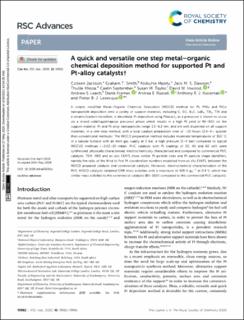A quick and versatile one step metal-organic chemical deposition method for supported Pt and Pt-alloy catalysts
| dc.contributor.author | Jackson, Colleen | |
| dc.contributor.author | Smith, Graham T. | |
| dc.contributor.author | Mpofu, Nobuhle | |
| dc.contributor.author | Dawson, Jack M. S. | |
| dc.contributor.author | Khoza, Thulile | |
| dc.contributor.author | September, Caelin | |
| dc.contributor.author | Taylor, Susan M. | |
| dc.contributor.author | Inwood, David W. | |
| dc.contributor.author | Leach, Andrew S. | |
| dc.contributor.author | Kramer, Denis | |
| dc.contributor.author | Russell, Andrea E. | |
| dc.contributor.author | Kucernak, Anthony R. J. | |
| dc.contributor.author | Levecque, Pieter B. J. | |
| dc.date.accessioned | 2021-08-18T09:08:57Z | |
| dc.date.available | 2021-08-18T09:08:57Z | |
| dc.date.created | 2021-02-16T16:35:32Z | |
| dc.date.issued | 2020 | |
| dc.identifier.citation | RSC Advances. 2020, 10 (34), 19982-19996. | en_US |
| dc.identifier.issn | 2046-2069 | |
| dc.identifier.uri | https://hdl.handle.net/11250/2770037 | |
| dc.description.abstract | A simple, modified Metal–Organic Chemical Deposition (MOCD) method for Pt, PtRu and PtCo nanoparticle deposition onto a variety of support materials, including C, SiC, B4C, LaB6, TiB2, TiN and a ceramic/carbon nanofiber, is described. Pt deposition using Pt(acac)2 as a precursor is shown to occur via a mixed solid/liquid/vapour precursor phase which results in a high Pt yield of 90–92% on the support material. Pt and Pt alloy nanoparticles range 1.5–6.2 nm, and are well dispersed on all support materials, in a one-step method, with a total catalyst preparation time of ∼10 hours (2.4–4× quicker than conventional methods). The MOCD preparation method includes moderate temperatures of 350 °C in a tubular furnace with an inert gas supply at 2 bar, a high pressure (2–4 bar) compared to typical MOCVD methods (∼0.02–10 mbar). Pt/C catalysts with Pt loadings of 20, 40 and 60 wt% were synthesised, physically characterised, electrochemically characterised and compared to commercial Pt/C catalysts. TEM, XRD and ex situ EXAFS show similar Pt particle sizes and Pt particle shape identifiers, namely the ratio of the third to first Pt coordination numbers modelled from ex situ EXAFS, between the MOCD prepared catalysts and commercial catalysts. Moreover, electrochemical characterisation of the Pt/C MOCD catalysts obtained ORR mass activities with a maximum of 428 A gPt−1 at 0.9 V, which has similar mass activities to the commercial catalysts (80–160% compared to the commercial Pt/C catalysts). | en_US |
| dc.language.iso | eng | en_US |
| dc.publisher | Royal society of chemistry | en_US |
| dc.rights | Navngivelse-Ikkekommersiell 4.0 Internasjonal | * |
| dc.rights.uri | http://creativecommons.org/licenses/by-nc/4.0/deed.no | * |
| dc.title | A quick and versatile one step metal-organic chemical deposition method for supported Pt and Pt-alloy catalysts | en_US |
| dc.type | Peer reviewed | en_US |
| dc.type | Journal article | en_US |
| dc.description.version | publishedVersion | en_US |
| dc.rights.holder | © The Royal Society of Chemistry 2020 | en_US |
| dc.source.pagenumber | 19982-19996 | en_US |
| dc.source.volume | 10 | en_US |
| dc.source.journal | RSC Advances | en_US |
| dc.source.issue | 34 | en_US |
| dc.identifier.doi | 10.1039/d0ra03001e | |
| dc.identifier.cristin | 1890542 | |
| cristin.ispublished | true | |
| cristin.fulltext | original | |
| cristin.qualitycode | 1 |
Tilhørende fil(er)
Denne innførselen finnes i følgende samling(er)
-
Publikasjoner fra CRIStin - SINTEF AS [5801]
-
SINTEF Industri [1566]

